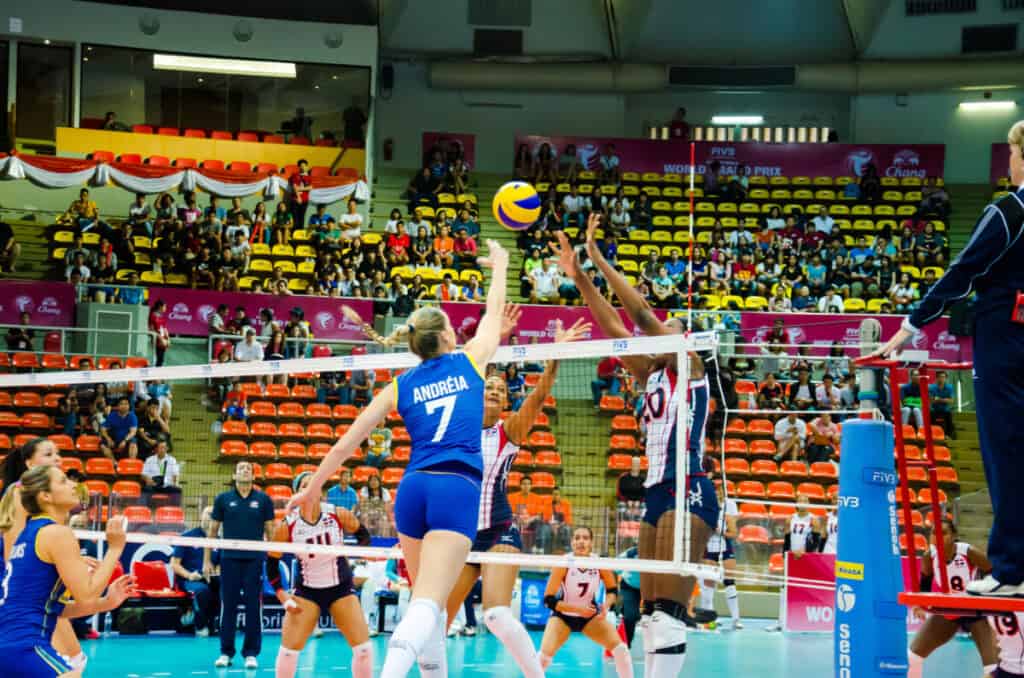When you’re new to volleyball you may not even know all the positions before you’re being asked, “What position do you play?” When you go to tryouts, especially for club volleyball, they will usually ask which position you are trying out for.
The decision on which position you should play will not be solely up to you. As with most sports, your coach will give you guidance along the way. You should pick the position that benefits from your strengths. This article will explore those ideas with you.
To get a better understanding of any of the positions, you need a basic concept of each of them so that you can see how they work together.
If you are new to volleyball and don’t know much about the different positions, start by reading this post first.
Best Position in Volleyball
The best position for you will be the position that you are already suited for depending on your athletic skills, your height, and your speed. As you progress in volleyball and you’ve learned the basic volleyball skills, you’ll find that you’re naturally better at some skills than others. That’s normal, and often that helps you find which position is right for you.
This chart has some of the traits that are most crucial for each position:
| Position | Most Valuable Qualities & Traits |
|---|---|
| Setter | Setting control – the ability to place the ball wherever their hitter needs it. Overall ball control – being able to handle both underhand or overhand setting. High Volleyball IQ – they need to know everyone’s job on every play, all the time. Decision-making – have to adapt constantly and make good decisions for the whole team. Communication – have to be able to call plays and signals during the rally. Leadership – very beneficial for this player to be the coach on the floor. |
| Libero | Ball control – they cover most of the court on defense to keep the ball in play. Passing – it’s crucial to have strong passing accuracy. Speed & Agility – being able to react and to get in position instantly. Digging – reading the hitters to be in a position to keep the ball up. Setting skills are a plus – they can’t attack, so they may back up the setter on bad plays. Often the shortest players, but not necessarily. |
| Defensive Specialist | All the libero qualities – very similar role. The ability to hit from the back row is a plus – hitting in space can be a challenge. |
| Middle (Blocker/Hitter) | Blocking – ranging all across the net to smother the opponent’s offense. Lateral agility – the ability to shift quickly to cover a lot of ground. Reading the setter – being able to quickly judge where the attack is going. Hitting – middles can be powerful and fast hitters because they are so close to the setter. Usually the tallest players on the team, but this is not a requirement, just a tendency. |
| Outside Hitter (Left) | Hitting – have to be able to hit a variety of sets. Blocking – both solo, or with the middle. Passing – whether in serve receive, or covering on defense. Ability to play all around – this is a bonus if they have all-around skills. |
| Opposite Hitter (Right) | Hitting – being able to hit off back sets and quick sets are their bread and butter. Blocking – often blocking the opponent’s best hitter (playing on the left). Being left-handed is a plus, it makes the approach more natural. The ability to set is a plus, they may play backup setter when the setter can’t get to it. |

Between your own perception of your volleyball skills, along with your coach and your parents, you should pick what seems to suit you best. When you try out for volleyball, coaches or clubs may ask what you’re trying out for, but don’t get too stuck on the idea of playing a particular position.
The truth is there isn’t a “best” position in volleyball. There’s a “best position for you in volleyball,” and that’s what you have to find.
Be open to trying different positions because that may get you on to a better team somewhere along your volleyball journey that you never considered. Some of the best players are players who have played different roles for different teams along the way and have developed into very well-rounded players as a result.
Best Position for Left-Handed Volleyball Players
Just like a right-handed player can play any position in volleyball, a left-handed player can play any position as well, but is there an advantage to playing a particular position?
A right-handed player has an advantage at playing the opposite hitter (the right-side hitter) because of the way they square up to the net to attack. Also, it can be an advantage as a setter because being left-handed will make it more natural to do a setter’s dump or even attack from the setter position.
By far, the most common place you’ll see a lefty play will be the right side, being the opposite hitter. When a left-handed hitter approaches from the right side, they have a much more open look at the court and can hit all the angles, just like a right-handed hitter from the left side.
Defenses are used to blocking and defending against right-handed hitters (even from the opposite position), so having a true lefty strike the ball changes the game. Not only will they hit a better sideline shot or a better cross, they will also put a different spin on the ball which is hard to compensate for.

Best Volleyball Position for Short Players
The best volleyball positions for short players are the positions that don’t require blocking or extensive hitting. So libero would be the ideal choice for short players, followed by defensive specialist or setter.
With the libero not being allowed to attack at all, it really is the best option for most short players. But not everyone can be a libero. There’s only 1 spot per team, or maybe 2 liberos on a roster, but only 1 can play at a time.
Defensive specialist would be the second-best option because there’s rarely a case where their height comes into play. Really the only advantage to being tall for a DS would be when they’re hitting from the back-row. Being tall can help get a better attack angle, but it really doesn’t matter as much for a DS.
Finally, the setter can be a position that short players can excel at. There is still a disadvantage to not being very strong at engaging in the blocking or an occasion hit (when they are in the front-row rotation). But predominantly the setter is required to focus on offense. If short players work very hard, they can usually get enough height to help with the blocking enough to not be a liability.
Would you like to shop for our favorite recommended player products? Choose the item below and click to shop on Amazon.
Should I Switch Volleyball Positions to Get Recruited?
It’s a tough decision when coaches have the talk with you where they say that they don’t really need you if you’re only going to play the same position you’ve always played, they need you to switch. Should you do it?
If a coach is asking you to consider switching volleyball positions to make their team, it depends on 2 things: how attached are you to your position, and how badly do you want to make this particular team.
How Attached Are You to Your Volleyball Position?
Sometimes your position can feel like a really big deal, but remember, volleyball is the sport, the game that you love. Is it really so important that you play a particular role that you would stop moving on and moving up because you’re unwilling to adapt?
Remember that sometimes coaches can see potential in us that we don’t see in ourselves. Maybe no one has ever seen that side of you before, but they believe they can turn you into a really great player in that position.
Sometimes, you just also have to know that they simply have too many outside hitters and if they’re going to take you, you need to be willing to learn to play opposite. If you agree to move forward you really need to give it all you’ve got. Don’t be the athlete who agrees to switch, but then resents having switched from then on.
How Badly Do You Want To Make The Volleyball Team?
This could be your high school team, your club team, or even a college team. Sometimes coaches will make it clear that they like you as a player, but you wouldn’t be as good at your position as someone else they already have.
Before you give up, really weigh your options. If this is a club team and you can choose to play for another club, then maybe this isn’t a big deal. But if this is your school team or a college opportunity, you’re pretty much deciding whether you keep playing volleyball or not. I would always recommend before you close that door, that you at least give it a try.
How many different football players were the best high school quarterback their city had ever seen but had to switch to wide receiver to play in college? How many different centers in basketball were always chosen as a center because they were the tallest kid around, but had to switch to playing forward or even guard later on when they got to the higher levels?
Remember, in some cases, some of the best players in any sport have made a transition and gone on to remarkable careers.
If you have other recruiting questions, make sure to check out this post all about it.
Volleyball Positions On The Court
When you talk about positions in volleyball, there are 2 kinds of positions. The first is the role that you play on the team, which this post is all about, then the other is the actual spot on the floor on which you are standing. If you would like to learn about that second kind of position, this video will help…
Photo Credits
Feature image by Piotr Drabik on flickr.com: https://creativecommons.org/licenses/by/2.0/, cropped to zoom in.
Recent Posts
Athletes, listen up! Do you have a closet full of old jerseys, sweatpants, and tees that you just can't seem to part with? Well, dust them off, because you're sitting on a goldmine of fashion...
You may have heard, or you may have noticed, that there's been a change to the rule about double contact in volleyball. In 2022, an experimental rule change began to be implemented, where the double...
